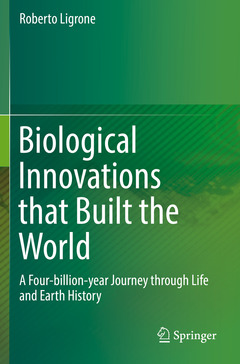Description
Biological Innovations that Built the World, 1st ed. 2019
A Four-billion-year Journey through Life and Earth History
Author: Ligrone Roberto
Language: English
Subjects for Biological Innovations that Built the World:
Publication date: 08-2020
Support: Print on demand
Publication date: 06-2019
490 p. · 15.5x23.5 cm · Hardback
Description
/li>Contents
/li>Biography
/li>Comment
/li>
1. Introduction
2. The Origins
2.1 Introduction
2.2 Birth of The Solar System2.3 The Earth
2.4 The Start of Tectonics
2.5 Tectonic Processes are Essential to Life
2.6 Genesis of The Atmosphere-Ocean-Continental Crust (AOC) System
3. The Birth of Life
3.1 Introduction
3.2 Seafloor Hydrothermal Vents as Settings for the Emergence of Life
3.3 A Primordial Role for RNA?
3.4 The Origin of the Genetic Code
3.5 A RNA-Protein World
3.6 Biological Membranes
3.7 From Geochemistry to Biochemistry: The Emergence of an Autonomous Metabolism
3.8 DNA Replaced RNA as the Repository of Biological Information3.9 The Bacteria-Archaea Membrane Divide: Ancestral or Derived?
3.10 Concluding Remarks
4. Moving to the Light: The Evolution of Photosynthesis
4.1 Introduction
4.2 Light, Pigments and Photosystems
4.3 Accessory Pigments
4.4 The Photochemical Process in Anoxygenic Bacteria
4.5 Evolutionary Interrelationships of Type-1 and Type-2 Photosystems
4.6 Oxygenic Photosynthesis4.7 Pathways of Carbon Photosynthetic Fixation
5. The Great Oxygenation
5.1 Introduction
5.2 Planetary Oxygen Balance
5.3 Methane was Probably a Key Driver of Planetary Oxygenation
5.4 The GOE was Associated with a Phase of Climatic Instability
5.5 After the GOE, the Earth Stabilized in a Low-Oxygen State for Over One Billion Years5.6 The Earth Entered a High-Oxygen Phase About 800 Million Years Ago
5.7 The Impact of Oxygen on Biological Evolution
6. Eukaryotes
6.1 Introduction
6.2 Rise and Fall of the Archaezoan Model of Eukaryogenesis
6.3 Post-Archaezoan Models
6.4 The Neomuran Model
6.5 The Origin of the Nucleus
6.6 Was the Host a Primitive Eukaryote or a Complex Archaeon?6.7 The Mitochondria
6.8 The Last Eukaryote Common Ancestor (LECA) had all the Fundamental Traits of Eukaryotic Cells
6.9 Eukaryote Phylogeny and Systematics
6.10 Timing of Eukaryote Appearance and Diversification
6.11 Concluding Remarks
7. Sexual Reproduction
7.1 Introduction7.2 Origin of Meiotic Sex
7.3 The Case of Parthenogenetic Rotifers
7.4 Sexual Reproduction Sets Strong Species Boundaries in Eukaryotes
7.5 Species Boundary in Prokaryotes is Conventional
7.6 Gamete Differentiation and Genders
8. Multicellularity
8.1 Introduction
8.2 Cellular Specialization and Levels of Organization in Multicellular Organisms
8.3 Stem Cells and Germ Line8.4 Concluding Remarks
9. The Chloroplast and Photosynthetic Eukaryotes
9.1 Introduction
9.2 Birth of the Primary Chloroplast
9.3 The Plants (Archaeplastida)
9.4 Secondary Chloroplasts
9.5 Phylogeny of Eukaryotes with Secondary Chloroplasts
9.8 Chloroplast Thieves and Other Stories
9.7 Plastid Division
9.8 Storage Polysaccharides
10. The Animals
10.1 Introduction10.2 Embryo Development and Body Symmetry
10.3 Animal Systematics
10.4 Cellular Junctions and Epithelia
10.5 The Intestine and Animal Evolution
10.6 Chordates
10.7 The Impact of Animals on the Global Environment
11. Land Plants
11.1 Introduction
11.2 An Early Step in Plant Terrestrialization was a Change in the Ancestral Life Cycle
11.3 Early Land Plants
11.4 Stomata and Homeohydry
11.5 Land Plant Systematics
11.6 The Xylem: A Lignified Water-Conducting System
11.7 Multiple Evolution of Leaves And Roots
11.8 Land Plants Have Co-Evolved with Fungal Symbionts11.9 The Impact of Land Plants on the Global Environment
12. The Emergence of Humanity
12.1 Introduction
12.2 The Evolution of Bipedality
12.3 Australopythecines
12.4 The Genus Homo
12.5 Origin and Diffusion of Modern Humans
12.6 Death from a Distance: High-Speed Throwing
12.7 Why are Humans Naked?
12.8 Reproductive Biology of Humans12.9 The Evolution of Language
12.10 The “Cognitive Revolution”
12.11 The Evolution of Cooperation and the Emergence of Culture
12.12 The Agricultural Revolution
12.13 The Evolution of Social Organization12.14 The Search for “Human” Genes
12.15 The Impact of Humanity on the Global Environment
13. Synopsis
14. Glossary
15. Analytic Index
Offers a comprehensive review of fundamental topics in integrative biology ranging from the appearance of life to the emergence of humans, with emphasis on environmental impact
Written from an integrative biological perspective
Contains a glossary of less common technical terms

